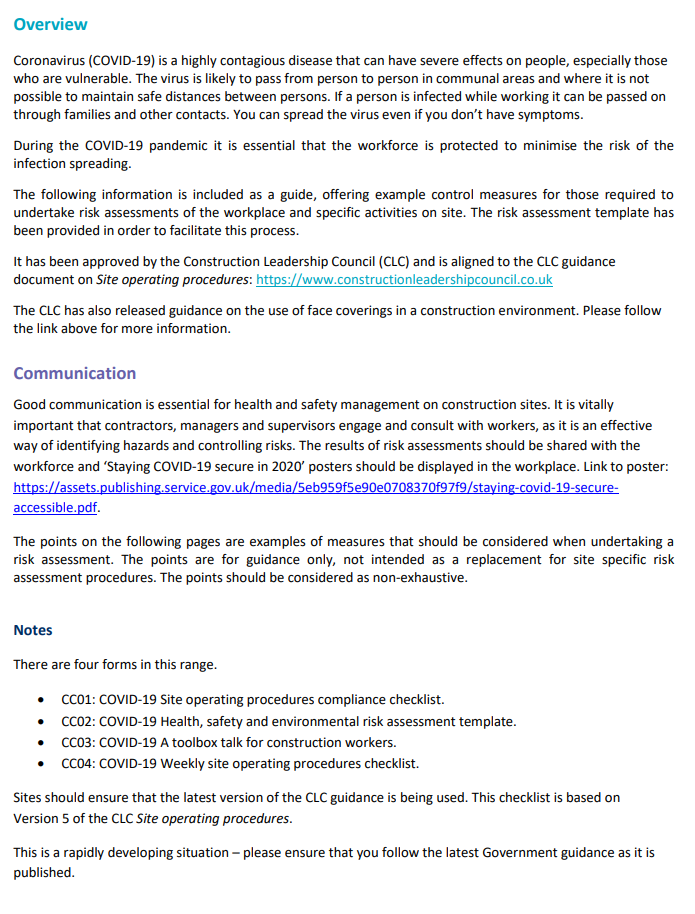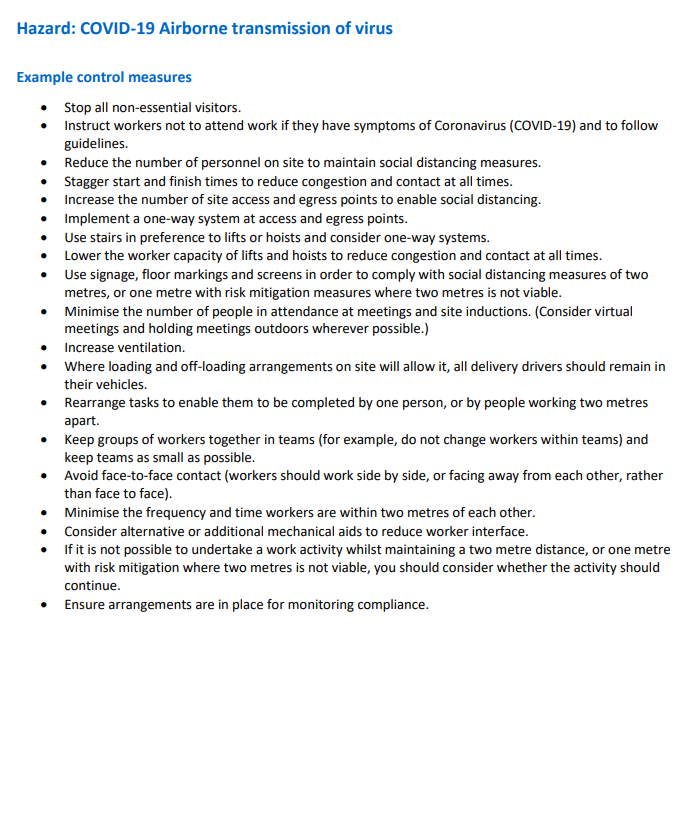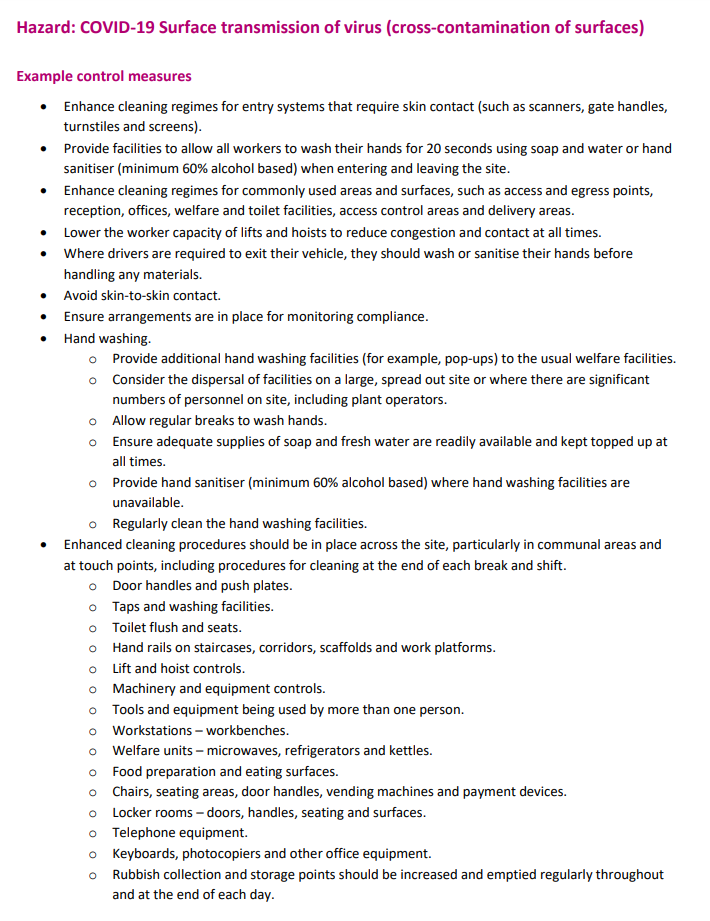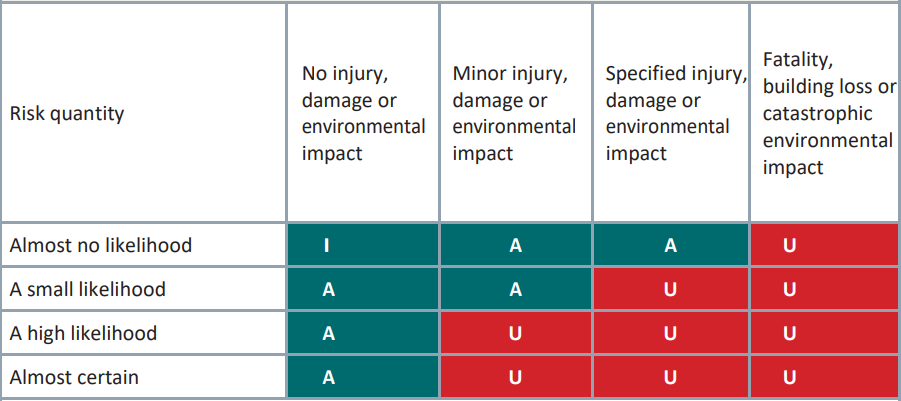Title Page
-
Company Name
-
Location
-
Project Title
-
Person Conducting Assessment
-
Date
-
Person Supervising Work
-
Date
-
Risk Assessment Number
-
COVID-19 – Health, Safety and Environmental Risk Assessment Overview (OFF to remove from print out)
-
-
-
-
Persons exposed
- Employees
- Other workers
- Public/visitors
- Young persons
- New/expectant mothers
- Vulnerable persons
- Others
-
Estimated total number of persons at risk
Hazards (What might cause harm?)
-
1. Adverse weather conditions
-
2. Cold
-
3. Electricity
-
4. Excavation
-
5. Fire/flammable atmosphere
-
6. Floor/ground conditions
-
7. Flying particles/dust
-
8. Hand or power tool
-
9. Hazardous substance
-
10. Heat/hot work
-
11. Lack of experience
-
12. Lack of training
-
13. Lack of/too much oxygen
-
14. Access
-
15. Lifting equipment appliances
-
16. Lighting
-
17. Loading/unloading
-
18. Materials
-
19. Moving parts of machinery
-
20. Proximity to water
-
21. Scaffold
-
22. Sharp objects
-
23. Stairs/steps
-
24. Static equipment/machinery
-
25. Structure
-
26. Temporary works
-
27. Vehicle/mobile equipment
-
28. Working hours/fatigue
-
29. Workstation design
-
30. Work at height
-
31. Third parties
-
32. Other
-
33. COVID-19 Airborne transmission of virus
-
34. COVID-19 Surface transmission of virus (cross-contamination of surfaces)
-
Comments (* All of the SHE descriptors can be an outcome of each hazard. S = Safety H = Health E = Environment)
-
Risk Factor
-
-
Notes
1. The listed hazards are the type of issues that may cause harm. Tick box for hazards.
2. Preventative/control measures are the actions that will stop it going wrong.
3. Control measures are to ensure that residual risks are reduced to a minimum. Where controls fail to reduce the risk to an acceptable level then refer assessment to your line manager.
4. If the operations are likely to affect the public or the safe operation of a public infrastructure or transport system, the control measures must reduce the likelihood of significant harm to the level that existed before work commenced.
5. Where young persons or expectant mothers are involved in the activity, ensure that any additional controls are put in place in accordance with legal requirements and local procedures.
6. In addition to the above, consideration must be given to other individuals’ susceptibility due to preexisting health conditions (such as respiratory, spinal or hearing conditions). Additional human factors (such as ergonomics and workplace design) should also be considered.
7. Where a hazard is identified that is not listed in the hazards list, enter the hazard description followed by ‘Other’ in brackets, for example (Other).
Hazard
-
Hazard number
- 1. Adverse weather conditions
- 2. Cold
- 3. Electricity
- 4. Excavation
- 5. Fire/flammable atmosphere
- 6. Floor/ground conditions
- 7. Flying particles/dust
- 8. Hand or power tool
- 9. Hazardous substance
- 10. Heat/hot work
- 11. Lack of experience
- 12. Lack of training
- 13. Lack of/too much oxygen
- 14. Access
- 15. Lifting equipment appliances
- 16. Lighting
- 17. Loading/unloading
- 18. Materials
- 19. Moving parts of machinery
- 20. Proximity to water
- 21. Scaffold
- 22. Sharp objects
- 23. Stairs/steps
- 24. Static equipment/machinery
- 25. Structure
- 26. Temporary works
- 27. Vehicle/mobile equipment
- 28. Working hours/fatigue
- 29. Workstation design
- 30. Work at height
- 31. Third parties
- 32. Other
- 33. COVID-19 Airborne transmission of virus
- 34. COVID-19 Surface transmission of virus (cross-contamination of surfaces)
-
Nature of risk (What might go wrong?)
-
Risk before controls
-
Control measures (How do you stop it going wrong?)
-
Control measures implemented by (name)
-
Risk after controls
-
Method statement required?
-
Method statement number
-
Additional risk assessment
- Noise
- COSHH
- Handling
- New/expectant mothers
- Asbestos
- Vulnerable persons
- Radiation
- Young persons
-
PPE
- Helmet
- Hearing
- Respiratory
- Eye
- Boots
- Gloves
- Hi-vis
- Others
Completion
-
Person Completing the Assessment (Name and Signature)
-
Position
-
Person Reviewing the Assessment (Name and Signature)
-
Position
-
Date to be Reviewed



















